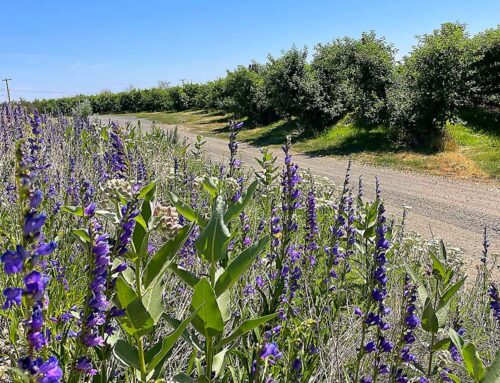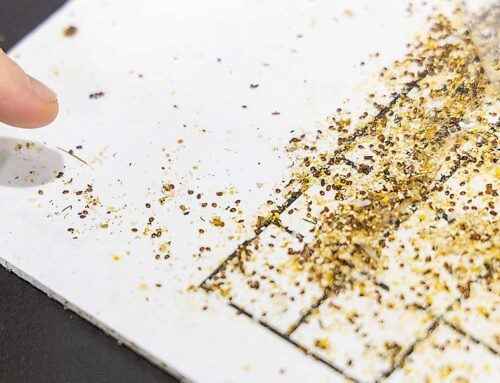
WSU bee geneticist Sue Cobey inseminates a virgin American honey bee with semen obtained from a Caucasian drone. (Courtesy of Washington State University)
They collected only semen so as to avoid a U.S. ban on bee importation imposed in 1922. Their goal is to increase adaptive traits in the American honeybee gene pool to help address environmental stressors that may be contributing to Colony Collapse Disorder (CCD) and other problems.
Myriad causes of CCD have been suggested, including chemicals, radiation from electronics, pests, pathogens, or a combination of factors. Of course, bees work in environments much transformed over the past century. Thus, the majority of bee researchers focus on mitigating the environmental changes challenging bees.

Washington State University bee geneticist Sue Cobey displays an array of virgin American honey bee queens. (Courtesy WSU)
Innovative beekeepers and the WSU bee researchers are taking different approaches.
“Bees are agriculture’s canary in a coal mine,” said Trevor Tauzer, a Central California commercial beekeeper. “When Colony Collapse Disorder started happening, we took steps to keep our bees healthy.”
Across the country beekeepers have adopted similar practices, including rotating hives to allow bees to forage beyond single crops and reduce their fatigue.
But many large-scale commercial beekeeping operations across the country, hard-pressed by vastly increasing demand, especially during California’s almond bloom, cannot afford to take their bees out of circulation. Thus the WSU researchers’ bee semen collecting trip to the Caucasus Mountains in the Republic of Georgia.
There were advantages and disadvantages to closing the U.S. borders to foreign bees back in 1922. An invasion of tracheal mites, which kill by infesting bees’ windpipes, was averted. However, after 1922, variation in the American honeybee gene pool declined significantly.
Over the years, wild European honeybees remaining in the American South did provide vitally unconventional genetic traits bee breeders used to improve American honeybees’ adaptive abilities. But a 1987 invasion of varroa mites (Varroa destructor) across the South wiped out the wild bees. The genetic bottleneck was effectively sealed.
Then, in 2008, the USDA issued the WSU bee geneticists a permit to import bee semen.
The Caucasian mountain honeybees have several desirable and adaptive traits the WSU geneticists hope will help American honeybees survive and thrive.
The Caucasians are adapted to cold mountain climates; they’ll fly in the chilly conditions of early spring in the Pacific Northwest as well as during California’s almond bloom. Also, the Caucasians produce huge amounts of propolis from plant resins they collect. Propolis serves these bees as a vital form of self-medication against pathogens.
In addition, Caucasian honeybees have evolved extremely long tongues, enabling them to collect nectar from a wider range of flowers than other bee subspecies. For farmers and orchardists in the Pacific Northwest, this means they’ll eventually have the option of investing in fewer bees to do the pollinating now performed by shorter-tongued Apis mellifera.
The U.S. Department of Agriculture issued the WSU bee geneticists a permit to import bee semen in 2008. Collecting bee semen is a simple straightforward process.
After a collector catches a drone bee, it’s simply a matter of gently squeezing the drone’s abdomen and, as the semen is exposed, drawing it into a syringe.
When Cobey and Sheppard returned to the WSU campus in Pullman, Washington, the semen they had brought back was rigorously tested for viruses. Then, with USDA approval, the geneticists inseminated virgin queens with the Caucasian semen.
The inseminated queens were released from quarantine in late August and distributed to Heitkam’s Honey Bees in Orland, California, and Strachan Apiaries in Yuba City, California. These cooperating queen producers are now supplying progeny to the American beekeeping industry, Cobey said. The WSU geneticists have also collected honeybee semen from sub-species in Italy and Slovenia to provide further bee breeding options.
Patrick Heitkam, owner of Heitkam’s Honey Bees, said that after receiving the inseminated breeder queens from Cobey, he propagated more queens and distributed them to 50 commercial beekeepers. “The jury is still out, but so far so good. We have not heard back any bad reports,” Heitkam said.
The beekeepers will not know for sure until spring how bees with the new traits will do in terms of brood and honey production. They were to be used in pollinating northern California’s almond crop.
The WSU geneticists’ efforts to improve variation in the American honeybees’ gene pool are ongoing. They have developed a repository in which bee semen is frozen in liquid nitrogen and stored. Samples will be thawed periodically and used to fine-tune the genetics of future generations of American honeybees. •
Brian Elsasser is a freelance writer based in Davis, California.





Leave A Comment